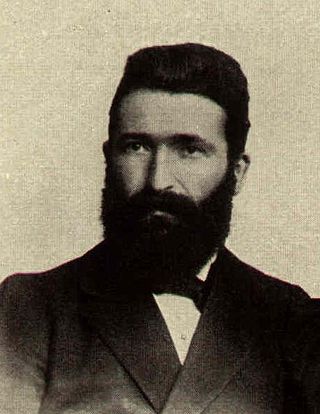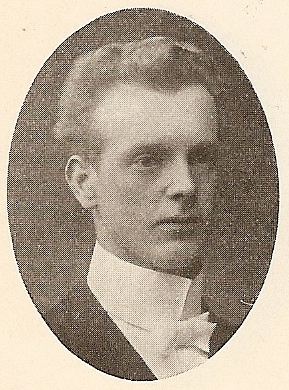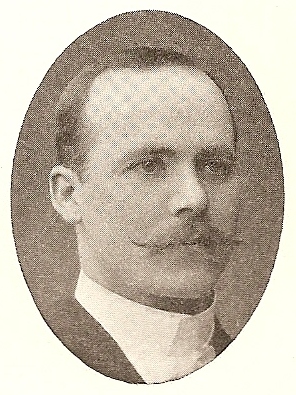
The Turkic Islamic Republic of East Turkestan (TIRET) was an independent republic centered on the city of Kashgar, located in the far west of Xinjiang Province. It is often described as the First East Turkestan Republic to differentiate it from the Second East Turkestan Republic (1944–1946).

In the early 19th century, Western colonial expansion occurred at the same time as an evangelical revival – the Second Great Awakening – throughout the English-speaking world, leading to more overseas missionary activity. The nineteenth century became known as the Great Century of modern religious missions.

Magnus Bäcklund was a Swedish missionary to Chinese Turkestan with the Mission Covenant Church of Sweden.

Johannes Avetaranian, born Mehmet Şükri was originally a mullah in Turkey who converted from Islam to Christianity, and later became a missionary for the Swedish Mission Covenant Church in Southern Xinjiang (1892–1938). He translated the New Testament into the Uyghur language. He preached Christianity in Xinjiang and at a Swedish Protestant mission. He died in 1919, aged 58, in Wiesbaden.

Gustaf Albert Ahlbert was a Swedish missionary and linguist. He served with the Mission Union of Sweden in Chinese Turkestan.
Rikard Nyström (1884–1943) was a Swedish missionary. He served with the Mission Union of Sweden in Chinese Turkestan.

Stina Mårtensson was a Swedish missionary. She served with the Swedish Missionary Society in Chinese Turkestan and India.
Rachel Orde Wingate was an English linguist and missionary to Xinjiang. She served with the Swedish Missionary Society.

John Törnquist was a Swedish missionary. He served with the Swedish Missionary Society in Chinese Turkestan.

Adolf Bohlin was a Swedish missionary. He served with the Mission Union of Sweden in Chinese Turkestan. Born Adolf Fredrik Persson in Tived, Skaraborg, Sweden, he was the ninth child of 12 for Per Erik Persson and Maja Cajsa Jacobsdotter. In late 1920 he moved to Los Angeles, California in the United States where he worked as a gardener until his retirement.

Gustaf Adolf Arell was a Swedish missionary and linguist. He served with the Mission Union of Sweden in Chinese Turkestan.

Women in China make up approximately 49% of the population. In modern China, the lives of women have changed significantly due to the late Qing dynasty reforms, the changes of the Republican period, the Chinese Civil War, and the rise of the People's Republic of China (PRC). Like women in many other cultures, women in China have been historically oppressed. For thousands of years, women in China lived under the patriarchal social order characterized by the Confucius teaching of "filial piety".

Josef Mässrur was a Christian Persian missionary to Chinese Turkestan with the Mission Union of Sweden.

Albert Andersson was a Swedish missionary to Chinese Turkestan with the Mission Covenant Church of Sweden. He also worked in Northern China with the Fransonska Mission.

Elin Karolina Svensson was a Swedish missionary. She served with the Mission Union of Sweden in Chinese Turkestan.

Hilda Lovisa Nordquist was a Swedish missionary. She served with the Mission Union of Sweden in Chinese Turkestan.

Anna Nyström-Mässrur was a Swedish missionary. She served in the Caucasus and in Persia, and in 1894 moved to the Xinjiang region of China.

The Kumul Rebellion was a rebellion of Kumulik Uyghurs from 1931 to 1934 who conspired with Hui Chinese Muslim General Ma Zhongying to overthrow Jin Shuren, governor of Xinjiang. The Kumul Uyghurs were loyalists of the Kumul Khanate and wanted to restore the heir to the Khanate and overthrow Jin. The Kuomintang wanted Jin removed because of his ties to the Soviet Union, so it approved of the operation while pretending to acknowledge Jin as governor. The rebellion then catapulted into large-scale fighting as Khotanlik Uyghur rebels in southern Xinjiang started a separate rebellion for independence in collusion with Kirghiz rebels. The various groups of rebels were not united. The main part of the war was waged by Ma Zhongying against the Xinjiang government. He was supported by Chiang Kai-shek, the Premier of China, who secretly agreed to let Ma seize Xinjiang.

The Manchu-led Qing dynasty of China ruled over Xinjiang from the late 1750s to 1912. In the history of Xinjiang, the Qing rule was established in the final phase of the Dzungar–Qing Wars when the Dzungar Khanate was conquered by the Qing dynasty, and lasted until the fall of the Qing dynasty in 1912. The post of General of Ili was established to govern the whole of Xinjiang and reported to the Lifan Yuan, a Qing government agency that oversaw the empire's frontier regions. Xinjiang was turned into a province in 1884.
In the 18th century, the Qing dynasty conquered the Junggar Basin (Dzungaria) and the Tarim Basin, uniting them under the name Xinjiang. Qing rule in Xinjiang is said to have negatively affected the position of women in the society of Turkic Muslims now known as the Uyghurs.


















